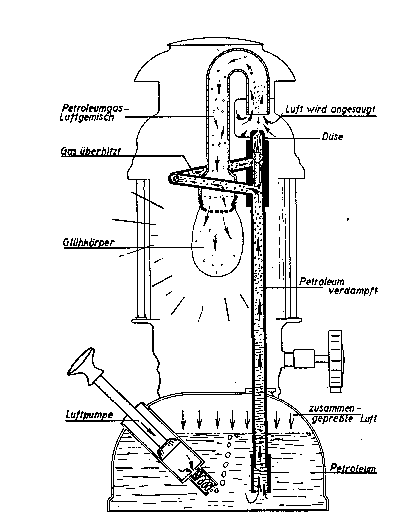| History of Petromax |
Kerosene Pressure Lantern Principles of Operation
Before long, the idea of using liquid fuels for this type of lighting was explored. By the end of the 19th century, the first alcohol and kerosene fueled incandescent lamps had been developed. These liquid fuel lamps used pressure to force the fuel towards the burner, and the heat of the burner's flame to vaporize the liquid fuel. They are thus often termed "pressure lamps / lanterns". One of the first and most successful kerosene fueled pressure lanterns was invented in 1910 by Max Graetz – the world famous Petromax. The Petromax lantern, and its smaller cousin the Geniol lantern, remain popular to this day, both in the private sector and for professional applications.
 The Petromax lantern acts as a small "gasworks". The fuel tank is pressurized to
approximately 2 atmospheres (2 bar, or 30 psi) with air introduced by a built-in
hand pump. This pressure is then used to force the liquid kerosene up into the
vaporizer (or "generator", as it is sometimes called). Initially, the vaporizer must
be pre-heated to gasify the liquid kerosene within it, prior to igniting the lantern's
mantle. This preheating may be accomplished by burning alcohol poured in to a
preheating cup located at the base of the vaporizer. Alternately, a built-in
kerosene-fueled blowtorch, the "Rapid" preheater located on the side of most
Petromax lanterns, may be used to heat the vaporizer. Once in operation, the
heat from the lantern's blue flame (encased within the mantle) is used to gasify
the liquid kerosene rising through the vaporizer. The liquid kerosene boils away
into vapor at approximately 250° C (480° F), about halfway up the height of the
vaporizer -- see illustration. The gaseous kerosene continues its journey through
the vaporizer's circular loop, increasing in temperature, until it exits the small
orifice in the vaporizer's nipple at nearly the speed of sound (1000 ft./sec.). Upon
exiting the nipple, the gaseous fuel begins to expand and combine with air in
small square chamber at the side of the lantern's inner casing. The expansion of
the gas and turbulent mixing with the air are responsible for the hissing noise of
the Petromax lantern while in operation. The gaseous kerosene and air are
swept into the mixing tube where the two are thoroughly combined in the
turbulent flow. This ensures complete combustion of the mixture upon exiting the
ceramic nozzle, resulting in a hot, clean blue flame.
The Petromax lantern acts as a small "gasworks". The fuel tank is pressurized to
approximately 2 atmospheres (2 bar, or 30 psi) with air introduced by a built-in
hand pump. This pressure is then used to force the liquid kerosene up into the
vaporizer (or "generator", as it is sometimes called). Initially, the vaporizer must
be pre-heated to gasify the liquid kerosene within it, prior to igniting the lantern's
mantle. This preheating may be accomplished by burning alcohol poured in to a
preheating cup located at the base of the vaporizer. Alternately, a built-in
kerosene-fueled blowtorch, the "Rapid" preheater located on the side of most
Petromax lanterns, may be used to heat the vaporizer. Once in operation, the
heat from the lantern's blue flame (encased within the mantle) is used to gasify
the liquid kerosene rising through the vaporizer. The liquid kerosene boils away
into vapor at approximately 250° C (480° F), about halfway up the height of the
vaporizer -- see illustration. The gaseous kerosene continues its journey through
the vaporizer's circular loop, increasing in temperature, until it exits the small
orifice in the vaporizer's nipple at nearly the speed of sound (1000 ft./sec.). Upon
exiting the nipple, the gaseous fuel begins to expand and combine with air in
small square chamber at the side of the lantern's inner casing. The expansion of
the gas and turbulent mixing with the air are responsible for the hissing noise of
the Petromax lantern while in operation. The gaseous kerosene and air are
swept into the mixing tube where the two are thoroughly combined in the
turbulent flow. This ensures complete combustion of the mixture upon exiting the
ceramic nozzle, resulting in a hot, clean blue flame.These principles of operation are generally applicable to any incandescent pressure lantern or lamp (e.g. – Coleman, Tilley, etc.), although fuel types, vaporization temperatures, and operating pressures / procedures may vary.
Thanks to John Baldessari and all the other kind helpers for this translation!
Copyright Jürgen Breidenstein jb@hytta.de | All rights reserved. Images: Graetz-Nachrichten
| History of Petromax |
